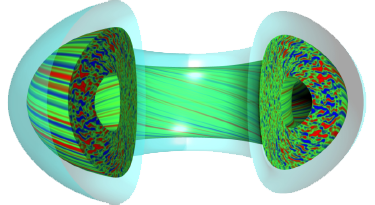Speaker
Description
Between-shots and real-time actuator trajectory planning will be critical to achieving high performance scenarios and reliable, disruption-free operation in present-day tokamaks, ITER, and future fusion reactors. Such tools require models that are both accurate enough to facilitate useful decision making and fast enough to enable optimization algorithms to meet between-shots and real-time deadlines. Both problems can be addressed with machine learning approaches. First, well-validated physics models can be used to train surrogate models that maintain high-fidelity at reduced computational complexity. For quantities that are not accurately modeled by available physics modules, machine learning can applied to available experimental databases to create fast empirical models. Combining the two approaches allows for predictive scenario modeling using high-fidelity physics models where available, and empirical models where necessary, with real-time relevant execution times.
The paper reports on a new empirical model for predicting kinetic profile shapes in tokamaks using neural networks. The model has been trained and tested on measured profiles from experimental discharges. Models have been developed for NSTX-U and NSTX electron pressure and density, as well as DIII-D electron/ion pressure/density and toroidal rotation. By projecting profiles onto empirically derived basis functions, the model is able to efficiently and accurately reproduce profile shapes. It has been found that the profile shapes can be quite accurately predicted with only scalar parameters as input, using no detailed source information or time history. This simplifies the profile prediction problem to specification of plasma current, boundary shaping descriptors, and prediction of volume averages of energy, density, and momentum. The latter can be modeled with a confinement scaling or other empirical models. A large database of profiles from the operation of NSTX has been used to test performance as a function of available data. It is found that the model learns quickly and shows promise for use in guiding exploration of operating space. The rapid execution time of the model is well suited to the planned applications, including optimization during scenario development activities, and real-time plasma control. A potential application of the model to real-time profile estimation is demonstrated.
| Country or International Organisation | United States of America |
|---|---|
| Affiliation | Princeton Plasma Physics Laboratory |

